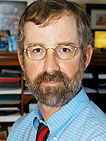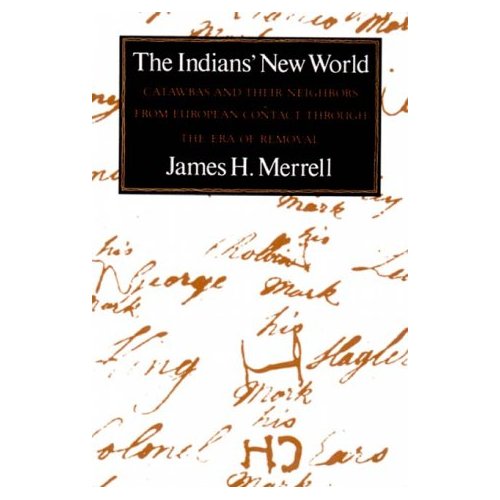The Scholars Speak: An Interview with Professor James Merrell
We are delighted to have Professor James Merrell of Vassar College. In the first chapter of Major Problems, his essay on “The Indians’ New World” highlights how radically transformative the age of encounter and contact was for Native Americans as well. Here’s his bio from Vassar, and the Q&A is below.
 Born and raised in Minnesota, Lucy Maynard Salmon Professor of History James Merrell studied at Lawrence University and Oxford University before receiving his Ph.D. from The Johns Hopkins University in 1982. Before coming to Vassar in 1984, he was a Fellow at The Newberry Library Center for the History of the American Indian in Chicago and the Institute of Early American History and Culture in Williamsburg, Virginia. He has also received fellowships from the American Council of Learned Societies, the John Simon Guggenheim Memorial Foundation, and the National Endowment for the Humanities.
Born and raised in Minnesota, Lucy Maynard Salmon Professor of History James Merrell studied at Lawrence University and Oxford University before receiving his Ph.D. from The Johns Hopkins University in 1982. Before coming to Vassar in 1984, he was a Fellow at The Newberry Library Center for the History of the American Indian in Chicago and the Institute of Early American History and Culture in Williamsburg, Virginia. He has also received fellowships from the American Council of Learned Societies, the John Simon Guggenheim Memorial Foundation, and the National Endowment for the Humanities.
Professor Merrell’s teaching and research interests are in early American history (up to 1830), particularly the Indian experience in colonial times. His first book, The Indians’ New World: Catawbas and Their Neighbors from European Contact through the Era of Removal (University of North Carolina Press, 1989) won the Frederick Jackson Turner Award and the Merle Curti Award from the Organization of American Historians as well as the Bancroft Prize. His second book, Into the American Woods: Negotiators on the Pennsylvania Frontier (W.W. Norton, 1999), was a Finalist for the Pulitzer Prize, and won Professor Merrell his second Bancroft Prize, making him only the fifth historian ever to win that prestigious award twice.
1) Why were you first drawn to early American history?
The short answer is two words long: Doug Greenberg. I went to college at Lawrence University, in Appleton, Wisconsin. The place had lots of terrific professors, especially in the History Department, but for me the most inspiring was Doug, then just out of grad school. I got a sense from him (this was the early-mid 1970s) that early America was a fascinating and strange place, and that it was then a very exciting place to be doing scholarship. I was hooked.

2)
Major Problems in American History sets up the first major problem in US history as one related to contact with Europeans. You suggest that the age of encounter created a “new world” for Indians. Do you still think this is the case, and what would you say were the biggest changes for Native Americans?Yes, I do still think that the idea of “new world” works in helping us understand what went on in the centuries after Europeans first began arriving in their new world. The challenges of unfamiliar and devastating diseases, alien technologies and modes of exchange, colonial expansion, and the arrival of colonial farmers constituted, for Catawbas as for other Native peoples, an array of challenges that, together, ushered in a profound change in the character of the Native experience.
That said, I would now stress more strongly, in light of scholarship since, that the impact of Europeans’ arrival was even slower to reshape life than I suggested. I would also think through a bit more what “new world” means: Did it come to Indian Country from outside? (As in “European colonists ‘brought’ a new world.”) Did Catawbas create their new world? Did they fashion it along WITH European colonists and African slaves? And, for that matter, how many “new worlds” are we talking about in that time and place? Was there a Catawba New World, a Cherokee New World, etc.? An Indian New World, a European New World, etc.? Or was there one “new world” that all in North America were part of? I don’t have an answer to that question–but at least the question has now occurred to me to ask!
3) Major Problems now includes documents from the Atlantic slave trade in its chapter on first encounters, how do you see West Africans and/or the early slave trade fitting with your essay and the debate over a new world created for Native Americans with and after the first encounters?
As your book attests, the landscape of “colonial American history” has changed dramatically since I published that essay. Among other things, it is more attuned to the notion of an Atlantic World, of which of course the slave trade was a major part. Enlightened by that work, I would certainly be even more attuned to the wider currents into which Native Americans were drawn. And I would also have worked harder to bring the arrival of African peoples on American shores into the fabric of interpretation I fashioned. (As it happens, the same year I published “The Indians’ New World,” I also published, in The Journal of Southern History, “The Racial Education of the Catawba Indians,” which dealt with Catawbas’ response to the racial realities of colonization. That said, some aspects of that story should have found their way into the “New World” essay.
Speaking of the slave trade, another realm of early American history that has been illuminated in the past generation or so is not only the African slave trade but the Indian slave trade. Allan Gallay, Paul Kelton, and many other scholars have shown the extent–both in numbers and in geographical range–of this system, and that, too, belongs in the stories we construct about that era.
4) If you had to set up a debate about this time period differently, how would you do it? What would be in the principle contest or major problem? What would be the take home message for students?
I’m not sure it’s about changing the debate, exactly, but one of the things I’m interested in talking about these days is the very language we use to talk about early America, language I have myself used, often, without being full cognizant of its being loaded. We no longer use terms like “savage,” “primitive,” “superstitious,” and the like, but still in common currency are terms that more subtly reinforce the perspective of the winners (Europeans): precontact implies that Natives had no contact with foreigners before 1492; discovery; settlement/settler; wilderness; and so on. Some will say this is political correctness run amok; I say otherwise, that it’s not political correctness, just correctness!
5) What are you working on now or are there any of your more recent articles or books that would help students more interested in this topic?
Speaking of terminology, I have an essay on this in an upcoming issue of the
William and MaryQuarterly. People might also be interested in the Introduction I wrote for the 20th-anniversary edition of The Indians’ New World. In about 10 pages, I offer some background on how I came to the subject of Indians, and how I see the book, its themes, its weaknesses and blind spots, in light of my own further thinking and the education I’ve gotten from other scholarly work.
 Born and raised in Minnesota, Lucy Maynard Salmon Professor of History James Merrell studied at Lawrence University and Oxford University before receiving his Ph.D. from The Johns Hopkins University in 1982. Before coming to Vassar in 1984, he was a Fellow at The Newberry Library Center for the History of the American Indian in Chicago and the Institute of Early American History and Culture in Williamsburg, Virginia. He has also received fellowships from the American Council of Learned Societies, the John Simon Guggenheim Memorial Foundation, and the National Endowment for the Humanities.
Born and raised in Minnesota, Lucy Maynard Salmon Professor of History James Merrell studied at Lawrence University and Oxford University before receiving his Ph.D. from The Johns Hopkins University in 1982. Before coming to Vassar in 1984, he was a Fellow at The Newberry Library Center for the History of the American Indian in Chicago and the Institute of Early American History and Culture in Williamsburg, Virginia. He has also received fellowships from the American Council of Learned Societies, the John Simon Guggenheim Memorial Foundation, and the National Endowment for the Humanities. 2) Major Problems in American History sets up the first major problem in US history as one related to contact with Europeans. You suggest that the age of encounter created a “new world” for Indians. Do you still think this is the case, and what would you say were the biggest changes for Native Americans?
2) Major Problems in American History sets up the first major problem in US history as one related to contact with Europeans. You suggest that the age of encounter created a “new world” for Indians. Do you still think this is the case, and what would you say were the biggest changes for Native Americans?


Great piece, thanks for sharing. I think the problem of terminology is a vital one–one that we as teachers might not have all the answers to, but one that we should at least share with our students. Every Native American I know prefers to be called “Indian,” so that the term I use. That said, this still presents a problem of terminology, one that we’re better off discussing if not quite solving.